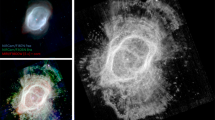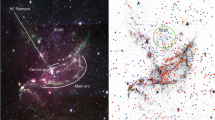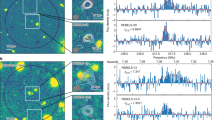Abstract
Flaring and warping of the disk of the Milky Way have been inferred from observations of atomic hydrogen1,2 but stars associated with flaring have not hitherto been reported. In the area beyond the Galactic centre the stars are largely hidden from view by dust, and the kinematic distances of the gas cannot be estimated. Thirty-two possible Cepheid stars (young pulsating variable stars) in the direction of the Galactic bulge were recently identified3. With their well-calibrated period–luminosity relationships, Cepheid stars are useful distance indicators4. When observations of these stars are made in two colours, so that their distance and reddening can be determined simultaneously, the problems of dust obscuration are minimized. Here we report that five of the candidates are classical Cepheid stars. These five stars are distributed from approximately one to two kiloparsecs above and below the plane of the Galaxy, at radial distances of about 13 to 22 kiloparsecs from the centre. The presence of these relatively young (less than 130 million years old) stars so far from the Galactic plane is puzzling, unless they are in the flared outer disk. If so, they may be associated with the outer molecular arm5.
This is a preview of subscription content, access via your institution
Access options
Subscribe to this journal
Receive 51 print issues and online access
$199.00 per year
only $3.90 per issue
Buy this article
- Purchase on Springer Link
- Instant access to full article PDF
Prices may be subject to local taxes which are calculated during checkout

Similar content being viewed by others
Change history
09 June 2014
Typos in refs 3, 18 and 26 were corrected in the HTML on 9 June 2014.
References
Kalberla, P. M. W., Dedes, L., Kerp, J. & Haud, U. Dark matter in the Milky Way. II. The H i gas distribution as a tracer of the gravitational potential. Astron. Astrophys. 469, 511–527 (2007)
Levine, E. S., Blitz, L. & Heiles, C. The vertical structure of the outer Milky Way H I disk. Astrophys. J. 643, 881–896 (2006)
Soszyński, I. et al. The optical gravitational lensing experiment. The OGLE-III catalog of variable stars. XIV. Classical and type II Cepheids in the Galactic bulge. Acta Astron. 61, 285–301 (2011)
Feast, M. W. in Planets, Stars and Stellar Systems (eds Oswalt, T. D. & Gilmore, G. ) Vol. 5, 829 (Springer, 2013)
Dame, T. M. & Thaddeus, P. Molecular spiral arm in the far outer Galaxy. Astrophys. J. 734, L24 (2011)
Ibata, R. A., Wyse, R. F. G., Gilmore, G., Irwin, M. J. & Suntzeff, N. B. The kinematics, orbit, and survival of the Sagittarius dwarf spheroidal galaxy. Astron. J. 113, 634–655 (1997)
Frinchaboy, P. M. et al. A 2MASS all-sky view of the Sagittarius dwarf galaxy. VII. Kinematics of the main body of the Sagittarius dSph. Astrophys. J. 756, 74 (2012)
Rich, R. M. in Planets, Stars and Stellar Systems (eds Oswalt, T. D. & Gilmore, G. ) Vol. 5 271 (Springer, 2013)
Matsunaga, N. et al. Three classical Cepheid variable stars in the nuclear bulge of the Milky Way. Nature 477, 188–190 (2011)
Fernie, J. D., Evans, N. R., Beattie, B. & Seager, S. A database of Galactic classical Cepheids. Inform. Bull. Variable Stars 4148, (1995)
Olling, R. P. On the usage of flaring gas layers to determine the shape of dark matter halos. Astron. J. 110, 591–612 (1995)
Carraro, G., Vázquez, R. A., Costa, E., Perren, G. & Moitinho, A. The edge of the young Galactic disk. Astrophys. J. 718, 683–694 (2010)
Ibata, R. A., Irwin, M. J., Lewis, G. F., Ferguson, A. M. N. & Tanvir, N. One ring to encompass them all: a giant stellar structure that surrounds the Galaxy. Mon. Not. R. Astron. Soc. 340, L21–L27 (2003)
Yanny, B. et al. A low-latitude halo stream around the Milky Way. Astrophys. J. 588, 824–841 (2003)
Bono, G. et al. Classical Cepheid pulsation models. X. The period-age relation. Astrophys. J. 621, 966–977 (2005)
López-Corredoira, M. et al. Comments on the “Monoceros” affair. http://arxiv.org/abs/1207.2749 (2012)
Purcell, C. W., Bullock, J. S., Tollerud, E. J., Rocha, M. & Chakrabarti, S. The Sagittarius impact as an architect of spirality and outer rings in the Milky Way. Nature 477, 301–303 (2011)
Soszyński, I. et al. The optical gravitational lensing experiment. The OGLE-III catalog of variable stars. II. Type II Cepheids and anomalous Cepheids in the Large Magellanic Cloud. Acta Astron. 58, 293–312 (2008)
Nishiyama, S. et al. Interstellar extinction law in the J, H, and Ks bands toward the Galactic center. Astrophys. J. 638, 839–846 (2006)
Pont, F., Queloz, D., Bratschi, P. & Mayor, M. Rotation of the outer disc from classical cepheids. Astron. Astrophys. 318, 416–428 (1997)
Nagayama, T. et al. SIRIUS: a near infrared simultaneous three-band camera. Proc. SPIE 4841, 459–464 (2003)
Skrutskie, M. F. The Two Micron All Sky Survey (2MASS). Astron. J. 131, 1163–1183 (2006)
Laney, C. D. & Stobie, R. S. Light-curve systematics of Cepheids in the infrared. Mon. Not. R. Astron. Soc. 260, 408–414 (1993)
Cardelli, J. A., Clayton, G. C. & Mathis, J. S. The relationship between infrared, optical, and ultraviolet extinction. Astrophys. J. 345, 245–256 (1989)
Nataf, D. M. et al. Reddening and extinction toward the Galactic Bulge from OGLE-III: The inner Milky Way's RV ∼ 2.5 extinction curve. Astrophys. J. 769, 88 (2013)
Soszyński, I. et al. The Optical Gravitational Lensing Experiment. The OGLE-III catalog of variable stars. I. Classical Cepheids in the Large Magellanic Cloud. Acta Astron. 58, 163–185 (2008)
Matsunaga, N., Feast, M. W. & Soszyński, I. Period-luminosity relations of type II Cepheids in the Magellanic clouds. Mon. Not. R. Astron. Soc. 413, 223–234 (2011)
Caldwell, J. A. R. & Coulson, I. M. BVI reddenings of Magellanic cloud Cepheids. Mon. Not. R. Astron. Soc. 212, 879–888 (1985)
Yong, D., Carney, B. W., Teixera de Almeida, M. L. & Pohl, B. L. Elemental abundance ratios in stars of the outer Galactic disk. III. Cepheids. Astron. J. 131, 2256–2273 (2006)
Groenewegen, M. A. T. Baade-Wesselink distances to Galactic and Magellanic cloud Cepheids and the effect of metallicity. Astron. Astrophys. 550, A70 (2013)
Inno, L. et al. On the distance of the Magellanic clouds using Cepheid NIR and optical-NIR period-Wesenheit relations. Astrophys. J. 764, 84 (2013)
Benedict, G. F. et al. Hubble Space Telescope fine guidance sensor parallaxes of Galactic Cepheid variable stars: period-luminosity relations. Astron. J. 133, 1810–1827 (2007)
Sandage, A., Tammann, G. A. & Reindl, B. New period-luminosity and period-colour relations of classical Cepheids. II. Cepheids in the LMC. Astron. Astrophys. 424, 43–71 (2004)
Zwitter, T., Castelli, F. & Munari, U. An extensive library of spectra covering the far red, RAVE and GAIA wavelength ranges. Astron. Astrophys. 417, 1055–1062 (2004)
Johnson, C. I., Rich, R. M., Fullbright, J. P., Valenti, E. & McWilliam, A. Alpha enhancement and the metallicity distribution function in Plaut’s window. Astrophys. J. 732, 108 (2011)
Marconi, M., Molinaro, R., Ripepi, V., Musella, I. & Brocato, E. Theoretical fit of Cepheid light and radial velocity curves in the Large Magellanic Cloud cluster NGC 1866. Mon. Not. R. Astron. Soc. 428, 2185–2197 (2013)
Sofue, Y. in Planets, Stars and Stellar Systems 5 (eds Oswalt, T. D. & Gilmore, G. ) 985 (Springer, 2013)
Jin, S., Grebel, E. K. & Haschke, R. Seeing Sagittarius through the bulge: tracing stellar stream stars in OGLE. IAU Symp. 298, 415 (2013)
Siegel, M. H. et al. The ACS survey of Galactic globular clusters: M54 and young populations in the Sagittarius dwarf spheroidal galaxy. Astrophys. J. 667, L57–L60 (2007)
Brunthaler, A. et al. The Bar and Spiral Structure Legacy (BeSSeL) survey: mapping the Milky Way with VLBI astrometry. Astron. Nachr. 332, 461–466 (2011)
Feast, M. W. The radial velocities of distant Cepheids and galactic models. Mon. Not. R. Astron. Soc. 136, 141–164 (1967)
Kerr, F. J. & Westerhout, G. in Galactic Structure (eds Blaauw, A. & Schmidt, M. ) 167 (Univ. Chicago Press, 1965)
Acknowledgements
The observations reported in this Letter were obtained with the Japanese–South African IRSF at Sutherland and the SALT. M.W.F., J.W.M. and P.A.W. gratefully acknowledge research grants from the South African National Research Foundation.
Author information
Authors and Affiliations
Contributions
M.W.F. coordinated the project and conducted the analysis. J.W.M. reduced the spectroscopic observations from SALT and determined the radial velocities. N.M. made and analysed the IRSF observations. All four authors contributed to the explanation and the discussion.
Corresponding author
Ethics declarations
Competing interests
The authors declare no competing financial interests.
Extended data figures and tables
PowerPoint slides
Rights and permissions
About this article
Cite this article
Feast, M., Menzies, J., Matsunaga, N. et al. Cepheid variables in the flared outer disk of our galaxy. Nature 509, 342–344 (2014). https://doi.org/10.1038/nature13246
Received:
Accepted:
Published:
Issue Date:
DOI: https://doi.org/10.1038/nature13246
This article is cited by
Comments
By submitting a comment you agree to abide by our Terms and Community Guidelines. If you find something abusive or that does not comply with our terms or guidelines please flag it as inappropriate.



